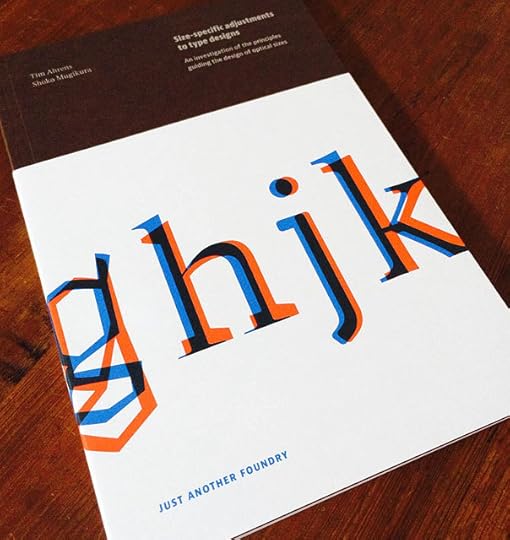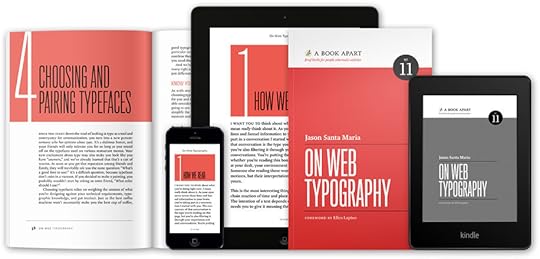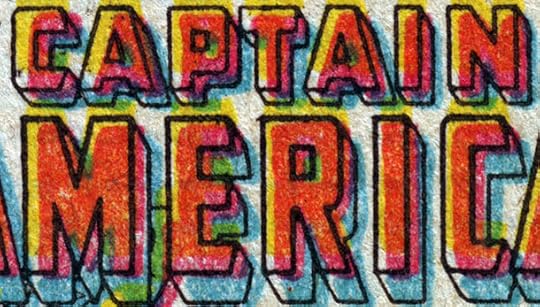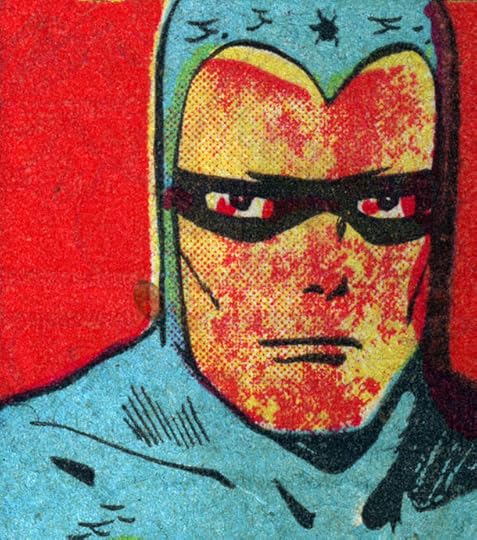Jason Santa Maria's Blog, page 4
September 2, 2014
Size-specific Adjustments to Type Designs

Tim Ahrens and Shoko Mugikura of Just Another Foundry have released an updated and expanded edition of Size-specific Adjustments to Type Designs:
The original version of this paper was written as part of Tim Ahrens’ MA in Typeface Design at the University of Reading in 2007. Tim first became engaged in the issue of optical sizes while he worked on the digitization and redesign of the Leipziger Antiqua (published as JAF Lapture in 2004). Through the project, he realised that although size-specific adjustments were commonly practiced for 500 years of metal type printing, not much documentation was available on the subject. This lead him to research and write about it himself, in the hope that the outcome would become a useful source for practitioners who wish to create fonts with size specific styles. The book looks into type history and perception psychology, and analyses designs by old masters as well as numerous contemporary designers.
I’m particularly interested in more widespread availablity and use of optical sizes for design on screen, where type is subjected to probably the widest variety of unknown, and sometimes harsh, conditions today.
“Optical sizes” are size-specific adjustments to type designs. They were practiced for 500 years of metal type printing. Since punches had to be cut separately for each type size, adjusting them accordingly did not involve any additional effort and the optical compensations were built into the fonts. Characters intended for use in small sizes typically show an increased width and x-height, reduced stroke contrast and looser spacing.
While this book is aimed more towards type designers, the material fills in a lot of the gaps in practice for typographers quite nicely too.
From the metal type era, hardly any documentation on the subject is available since punchcutting, like other crafts, was not discussed much in writing. The skills and insights were passed on from one master to the next by demonstration. Even today the design process of optically sized typefaces has rarely been recorded or analysed. This lack of resource lead Tim Ahrens to research and write about it himself in 2007, in the hope that the outcome would become a useful source for practitioners who wish to create fonts with size specific styles.
This is an insightful read behind the tools designers make (and use) everyday, and not to be missed. Grab a copy of Size-specific Adjustments to Type Designs today.

September 1, 2014
Interludes in Design
I’ve noticed something interesting happening in editorial design online. More articles, and websites in general, are focusing on slowing down to not only convey their story, but to set and maintain a mood for the reader. There are many ways to do this through the writing itself, but I wanted to take a moment to point out a way that design does this through small interludes.
To see what I mean, check out this story from Matter: This is what it’s like to be at war with your body.
It’s a well considered article design-wise, lots of nice typography and whitespace for starters, but look at the bits between the text. Sometimes it’s a large and exaggerated drop cap, a big photograph, or a splash or color, but look even closer. These elements share a visual language of size, color, and placement. Now look at the drop caps. They are trimmed asymmetrically, a visual reference to the subject of this story: voluntary amputation and body integrity identity disorder.
It’s a small detail, but it does a big thing. That little treatment, the photos, colors, big type, and pull quotes are all used to maintain a mood. They pop up at intervals to check in on the reader, and to keep the story moving. They function almost like the chorus of a song, maintaining a thread to a story, sometimes alluding to where you’ve been, where you’re going, or to punctuate a point in the journey.
It’s a technique that’s been popping up in a lot of places, but doesn’t often get scrutinized. I imagine it usually gets lumped into the idea of “longform” writing or art direction, but we don’t often talk about how much heavy lifting this little technique is doing.
Similar interludes are used to great effect in other mediums like film, music, and radio. Every week when I listen to This American Life or Radiolab, I know that the pauses between segments where the music volume rises are there for a reason: they support the story by keeping me in a particular mental space. These occurrences aren’t happenstance, they’re meticulously planned, and are in direct service of the listener. They give us a moment to reflect on the story so far and prepare for what’s next. They replenish a mood over and over again, so that we can continue along with that experience and feeling a certain thing.
Seeing this kind of consideration for storytelling on the web is a serious about face. Not because writers and designers haven’t cared about storytelling, but because we may be past the point where they could still be successful despite not caring. Offhandedly dumping text into a column on a webpage used to pass for an article, but the existence of a website isn’t novel by itself anymore.
Maybe folks on the web have grown more sophisticated. Maybe there is just too much out there to sift through and small considerations like this help us find the meat. I’m happy as a designer, and as a reader, to see more people taking the time to build things striving for greater significance.
Frank Chimero’s transcripts of some of his recent presentations, What Screens Want and Designing in the Borderlands, are an exceptional example, translated from one medium to another. The New York Times garnered lots of attention with Snowfall a couple years back, but they’ve continued investing in excellent longform and interactive storytelling. Organizations like ESPN and Vox Media have been up to the same even longer and continue to push out interesting reporting. And still more folks like Victory Journal and NPR are exploring the possibilities of reporting beyond only the written word.
Consideration for communication takes effort. It’s more than just the addition of some music or moving pictures, it’s a recognition of a broader story being told. Something bigger than text casually abandoned in the corral of a webpage. It’s the acknowledgement that a story can happen in multiple dimensions, across time, sound, and image. Our stories have an ebb and flow, and design serves to support and enrich them.
This piece originally appeared on The Pastry Box Project.

August 5, 2014
I Wrote a Book

I wrote a book called On Web Typography and it’s finally out. It’s inspired by a presentation of the same name I gave a couple years ago, but evolved into a record of most everything I’ve learned about typography in my career.
And despite this being a book about web typography, there isn’t a ton of code to be found. That’s because getting fonts onto a page has become pretty simple these days, and the CSS around styling type is pretty thoroughly documented too. What’s not heavily covered are the steps before all that stuff: like the reasons why you might choose one typeface over another; what it means to think about typography as a system; or how typography affects the process of reading.
Intangibles like these can be more difficult to discuss because there are often many good answers. Typography has a deep, rich history—but to many, that history feels vast and impenetrable. Even type-savvy designers can get frustrated by it, often when trying to make good, well-informed design choices. What’s more, for many designers, talking about these things can be uncomfortable if you don’t have the language to express what’s in your head.
Thing is, it doesn’t have to be this way: you can wield type like a superstar today, and I want to help show you how. My book wants to equip you with the skills to make confident decisions with typefaces and typography. It’s a fantastically detailed profession, but you already know more than you think.
It Takes a Village
This book was tough on me. I foolishly imagined it would take me about six months to draft up, and here I am years later with considerably more gray hair. The fact that this book exists is in large part due to the help, ideas, support, and—most important—patience selflessly imparted by friends and colleagues. I’ve learned that writing a book takes a village.
My deepest thanks to Jeffrey Zeldman for taking me under his wing many years ago and always being there for me as an inspiration, mentor, and friend. Tina Lee and Mandy Brown, the best editors I can imagine, make me sound like a much better writer than I am and also constantly pushed for clarity in communication. Katel LeDu seems superhumanly unflappable and was the guiding light during this whole process. Nick Sherman made sure I kept my foot out of my mouth and helped with numerous figures and references; he remains one of the sharpest typographic minds in our industry. Nicole Fenton and Caren Litherland made astute observations while editing and found the right spaces between the words. I’m also grateful to everyone who helped with thoughts and ideas along the way, including our entire A Book Apart family of colleagues and authors. I imagine I will still be thanking them for years to come.
Last, and the furthest possible thing from least, I am still weeping tears of joy that Ellen Lupton wrote my book’s foreword. Her prolific work, writing, and teaching have influenced me more than I can put into words.
I can’t tell you how excited I am to share this book with you, but I’ve been feeling like this ever since it went to the printer. I hope you enjoy it too!
Bonus: You can check out a book excerpt from Chapter 1 over at A List Apart: How We Read.

August 1, 2014
The Adobe Illustrator Story
The Adobe Illustrator Story is a great short documentary with a behind-the-scenes view of how the software came to be:
When Adobe Illustrator first shipped in 1987, it was the first software application for a young company that had, until then, focused solely on Adobe PostScript. The new product not only altered Adobe’s course, it changed drawing and graphic design forever.
Adobe Illustrator was the first design application I learned how to use, and my mind still works very much in line with how Illustrator works. Whether or not it was the countless hours I spent drawing curves one point at a time, learning Illustrator made me feel empowered by my computer. Like I was working with it, rather than trying to trick it into doing what I wanted.

July 17, 2014
What’s Next
In the back of my head is always a thought: What will I do when I stop designing websites?
It’s not because I want to stop—I love what I do—it’s that I wonder how long I can expect to do it. I don’t think it’s unrealistic to think that there will be a time when I don’t want to, or can’t—due to fatigue or professional obsolescence—work in this industry anymore. It may not happen, but planning for that possibility isn’t a bad idea either.
I think about this stuff because the speed of life and our industry can be humbling and terrifying all at once. It’s not just about keeping up with the latest techniques or news, but also finding time to continue developing the skills you have. There’s never really an end point to learning, just different plateaus of understanding.
Not long ago I was having a conversation with a friend who wondered if web designers might go the way of typesetters. Type used to be painstakingly set by hand, letter by letter. But that laborious process, as well as the skill involved, was subsumed by faster typesetting technologies like the Linotype machines. Later still, most Linotype operators were made redundant by computers. Advancements and displacement aren’t new things—I’m sure there was a time that scribes using clay tablets shook their fists at those snooty papyrus jerks—but it’s a cyclical thing.
With so much money flying around for valuations and acquisitions every week, no one would fault you for thinking our industry isn’t a stable one. Whatever ways things change, being mindful that they will change is a smart perspective, lest we all become today’s Luddites.
The stories we tell of the drive of faster automation and industrialization are cautionary tales, not because of the rise of machines, but because of our own stubbornness. Like many designers, I’m also afflicted with the fetishization of past parallels for what I do now. I love books and manually set typography—the byproduct of hard labor with one’s own hands to produce something unique and beautiful. But I also delight in how much more is possible for communication and connection with today’s tools.
I’m not entirely sure what options I would have if I wasn’t a designer. There are certainly themes throughout most everything I’ve done so far in life. Art. Drawing. Color. Type. Rhythm. I’ve invested so much time and energy into doing this, and the drive I had in my youth certainly made things easier. I have that same drive now, but sometimes it’s feels like it’s shifted towards deeper understanding rather than broad learning. I like getting further into the details of topics. And that’s when I get scared that I’ll get caught unawares by progress, like a twisted game of musical chairs.
Standing with one foot in the past and one in the future is a good thing. It honors those that came before and their work, but also incorporates progress. Maybe the key is not getting caught flat-footed when the future makes a shift. Flexibility in work habits and in thinking, rather than languages and programs, might be our most useful skills.
This piece originally appeared on The Pastry Box Project.

April 28, 2014
A Lifetime Odyssey
Sasha Sagan, daughter of famed astronomer Carl Sagan, wrote a wonderful piece about her father and how life is both terrifying and exciting:
When you consider the nearly infinite number of forks in the road that lead to any single person being born, they said, you must be grateful that you’re you at this very second. Think of the enormous number of potential alternate universes where, for example, your great-great-grandparents never meet and you never come to be. Moreover, you have the pleasure of living on a planet where you have evolved to breathe the air, drink the water, and love the warmth of the closest star. You’re connected to the generations through DNA — and, even farther back, to the universe, because every cell in your body was cooked in the hearts of stars. We are star stuff, my dad famously said, and he made me feel that way.
Sagan’s 1980 series Cosmos is back with new life thanks to an updated take from Neil deGrasse Tyson, Ann Druyan (Sagan’s widow), and Seth MacFarlane. The series is fantastic, paying homage to Sagan while celebrating science, learning, and the unknown all around us. And a lesser known, but equally notable, result came of this new endeavor:
But there is something else Seth did for my father’s legacy that has been significantly less tweeted about: He made it possible for all the contents of the Sphinx Head Tomb — all the essays on nuclear winter, the papers on the climate of Venus, the scraps of ideas, a boyhood drawing of a flyer for an imagined interstellar mission — to be preserved in the Library of Congress.

On the Job
My grandfather was a carpenter. He built many houses, including his and my grandmother’s, and my family’s home. He always had a pickup truck because that was his means to signal to the world that he was in business. Even after he had retired, he insisted on having a pickup truck so that he would always have the option to work if he needed it. That was a door he never wanted to close.
His friends and coworkers would meet at a local diner every morning for breakfast and to have a few laughs. I remember passing the diner on my morning school bus ride and seeing his and his friends’ pickup trucks lined up in the parking lot. They all had trucks too because this was how they told the world, and one another, that they were working.
I admire my grandfather for a great many things, but most for teaching me about craft and good day’s work. He could swing a hammer and liked making things with his hands, and until the end, wanted to be perceived as someone who could so. That was essential to him because he identified himself by the things he made.
And he made good on that. After retirement, he built a few more houses, including my family’s. He let me help with that one, and though I was only six, I tell myself the tangle of boards I nailed together in an adjacent pile of dirt were totally load-bearing. He taught me how to swing a hammer and how important it was to level your work and measure twice.
His truck, his hammer, his group of friends, all meant he was on the job. And most importantly, that he always had the potential to make something.
This piece originally appeared on The Pastry Box Project.

April 7, 2014
Four Color Process

I’ve been reading comic books off and on since I was little. There was a time when I thought I’d like to pursue a career in drawing comics. I enjoy the medium immensely for both its art and storytelling explorations. The art in particular has always held a place in my heart, which is why when I found John Hilgart’s Four Color Process blog I lost most of a morning pouring through the images.

I appreciate the technology many of us use to read comics now, but seeing the dots and registration (or lack thereof) has a quiet human charm, not unlike seeing the texture of an artist’s brush strokes in a beloved painting.
Also from Hilgart and not to be missed: SUPERTYPE!, the lettering of comic book mastheads, and Comic Book Cartography, maps, diagrams, and cutaways.

March 17, 2014
Ask a question
When I want to find out more about my own work, I ask a question. When someone asks me to look at their work, I ask a question. It’s a silly thing to say, but it took me years to do that.
It’s silly because it’s probably obvious to you, or to anyone who’s thought about it for a moment: If you want to get a better understanding of something, asking a question is infinitely more useful than making a statement.
It took me years to get there because I fell into the same trap many young designers do when in a critique—I tried to participate by offering answers.
Answers are appealing, of course, as is the idea of a charismatic leader who has pockets full of them. But of all the work I’ve done, the projects I consider most successful were accomplished by teamwork. Answers shouldn’t come from one single person, no matter how skilled they may be. Instead, they come as a result of discussion among peers.
Asking questions is at the heart of collaboration, more so than any project management software or process. And if you want to truly collaborate, I’ve found you need to allow yourself to be someone without the answers.
This piece originally appeared on The Pastry Box Project.

March 10, 2014
Philadelphia Fade Out
I was born and raised in Philadelphia, so when I travel I often get weird looks when I ask for a glass of wooder, and man do I miss good sawff pressle. Last week The New York Times published a great piece on the unique Philly sound:
No vowel escapes diphthongery, no hard consonant is safe from a mid-palate dent. Extra syllables pile up so as to avoid inconvenient tongue contact or mouth closure. If you forget to listen closely, the Philadelphia, or Filelfia, accent may sound like mumbled Mandarin without the tonal shifts.
That wonderful Philly accent that still says hewm to me is disappearing:
A recent study out of the University of Pennsylvania reported that, like many regional phenomena, the Philly sound is conforming more and more with the mainstream of Northern accents. […] Nowhere but in the Delaware Valley can you hear those rounded vowels — soda is sewda, house is hay-ouse — a clear influence from Baltimore and points south.

Jason Santa Maria's Blog
- Jason Santa Maria's profile
- 5 followers



